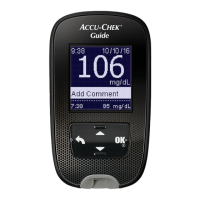59
Technical Information
10
other devices. In addition, the device should
operate normally in the presence of other
devices.
In the event there is interference from
another device, it is recommended that you
increase the distance between the meter and
that device. You can also turn o the
interfering device. In addition, you can turn
o Bluetooth low energy wireless technology
on the meter. Changes or modifications to
the device not expressly approved by Roche
could void the user’s authority to operate the
device. The device has been tested and
found to comply with the limits for a Class B
digital device. The device generates, uses,
and can radiate radio frequency energy.
Electromagnetic Compatibility – This
meter meets the electromagnetic immunity
requirements as per ISO 15197. The chosen
basis for electrostatic discharge immunity
testing was basic standard IEC 61000-4-2. In
addition, the meter meets the
electromagnetic emissions requirements as
per EN 61326-2-6 / EN 60601-1-2. The
meter’s electromagnetic emission is thus
low. Interference from the meter to other
electrically-driven equipment is not
anticipated.
This device complies with Part 15 of the FCC
Rules. Operation is subject to the following
two conditions:
1. This device may not cause harmful
interference, and
2. this device must accept any interference
received, including interference that may
cause undesired operation.
This equipment complies with FCC and IC
radiation exposure limits set forth for an
uncontrolled environment. This equipment is
in direct contact with the body of the user
under normal operating conditions. This
transmitter must not be co-located or
operating in conjunction with any other
antenna or transmitter.
NOTE
This equipment has been tested and
found to comply with the limits for a Class
B digital device, pursuant to Part 15 of the
FCC Rules. These limits are designed to
provide reasonable protection against
harmful interference in a residential
installation. This equipment generates,
uses, and can radiate radio frequency
energy and, if not installed and used in
accordance with the instructions, may
cause harmful interference to radio
communications. However, there is no
guarantee that interference will not occur
in a particular installation. If this
equipment does cause harmful
interference to radio or television
reception, which can be determined by
turning the equipment o and on, the
user is encouraged to try to correct the
interference by one or more of the
following measures:
• Reorient or relocate the receiving
antenna.
• Increase the separation between the
equipment and receiver.
• Connect the equipment into an outlet on
a circuit dierent from that to which the
receiver is connected.
• Consult the dealer or an experienced
radio/TV technician for help.
Changes or modifications not expressly
approved by the party responsible for
compliance (i.e. the manufacturer) could void
the user’s authority to operate the
equipment.
82052_08100918004.indd 59 6/9/2020 12:09:34 PM

